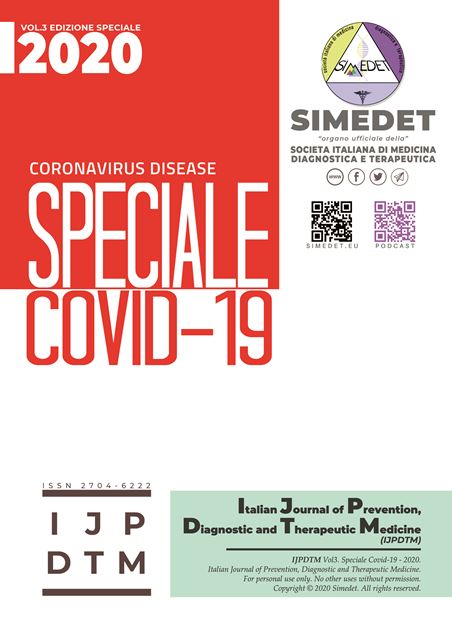The role of the laboratory in coronavirus diagnostics
Main Article Content
Abstract
This article highlights the role of laboratory diagnostics, peculiar to favoring the diagnosis of Covid19, defined as a real world emergency that has taken on the characteristics of a pandemic.
The objective was to present the activities carried out within the Microbology and Virology Laboratory of the Padua AOU, involved at the forefront of this health emergency in the Veneto region.
The protocols and methods used in molecular diagnostics have been described as the gold standard for the identification of infectious cases from SARS-CoV-2, through the use of advanced technologies.
Recent serological tests (for antibody or antigenic detection) intended to play an important role in research and epidemiological surveillance have also been described.
Finally, the highly qualified role of the Biomedical Laboratory Technician was highlighted, which, like the other health professionals, must be suitably trained and updated on the prevention and protection measures available, as well as
on the characteristics of the clinical picture of COVID-19.
Downloads
Article Details

This work is licensed under a Creative Commons Attribution-NonCommercial-NoDerivatives 4.0 International License.
References
Ceraolo C, Giorgi FM. Varianza genomica del coronavirus 2019-nCoV. J Med Virol 2020.
Mattiuzzi C, Lippi G. Quali lezioni dovremo imparare dal nuovo focolaio di coronavirus del 2019?Ann Transl Med 2020; 8: 48.
Wu Z, McGoogan JM. Caratteristiche e importanti lezioni dall’epidemia di coronavirus 2019 (COVID-19) in Cina: sintesi di un rapporto di 72 314 casi dal centro cinese per il controllo e la prevenzione delle malattie. J Am Med Assoc 2020.
Lippi G, Plebani M. Una definizione moderna e pragmatica di Medicina di laboratorio. Clin Chem Lab Med 2020. doi: . [Epub prima della stampa].
Lippi G, Plebani M. L’epidemia del nuovo coronavirus (2019-nCoV): pensa l’impensabile e sii pronto ad affrontare la sfida. Diagnosi (Berl)2020.
Holmes KV, SARS- associated coronavirus . N Engl J Med 2003;348;1948-51.
European Center for Disease Control (ECDC). Rapid risk assessment: outbreak of acute respiratory syndrome associated with a novel coronavirus, China https://www.ecdc.europa.eu/sites/default/files/documents/novel-coronavirusrisk-assessment-china-31-january- 2020_0.pdf
World Health Organization (WHO). Novel Coronavirus (2019-nCoV) situation reports. https://www.who.int/emergencies/diseases/novel
Ksiazek TG, Erdman D, Goldsmith CS, Zaki SR, Peret T, Et Al, SARS Working Group. A novel coronavirus associated with severe acute respiratory syndrome. N Engl J Med 2003; 348;1953-66.
Drosten C, Gunther S, Preiser W, van der Werf S, Brodt HR et al. Identification of a novel coronavirus in patients with severe acute respiratory sindrome N Engl J Med 2003;348; 1967-76 .
Guidance “Laboratory testing strategy recommendations for COVID-19” (WHO) .
Hoey J. Updated SARS case definition using laboratory criteria. CMAJ 2003;168;1566-7.
Meyer et al - “However, Woo et al. (2004b) - Okba et al., SARSCoV- 2 specific antibody responses in COVID-19 patients, medRxiv 2020. doi:10.1101/2020.03.18.20038059”.
Antibody responses to individual proteins of SARS coronavirus and their neutralization activities.
Da Documento INAIL COVID-19 e protezione degli operatori sanitari 02/03/2020) https://www.inail.it/cs/internet/comunicazione/pubblicazioni/catalogo-generale/pubbl-covid-19-operatori-sanitari.html .
Linee Guida emanate dalla World Health Organization (WHO) -27 Febbraio 2020.
World Health Organization - COVID-19 Guideline.

